clock Seat Ateca 2017 Owner's Manual
[x] Cancel search | Manufacturer: SEAT, Model Year: 2017, Model line: Ateca, Model: Seat Ateca 2017Pages: 328, PDF Size: 6.36 MB
Page 38 of 328
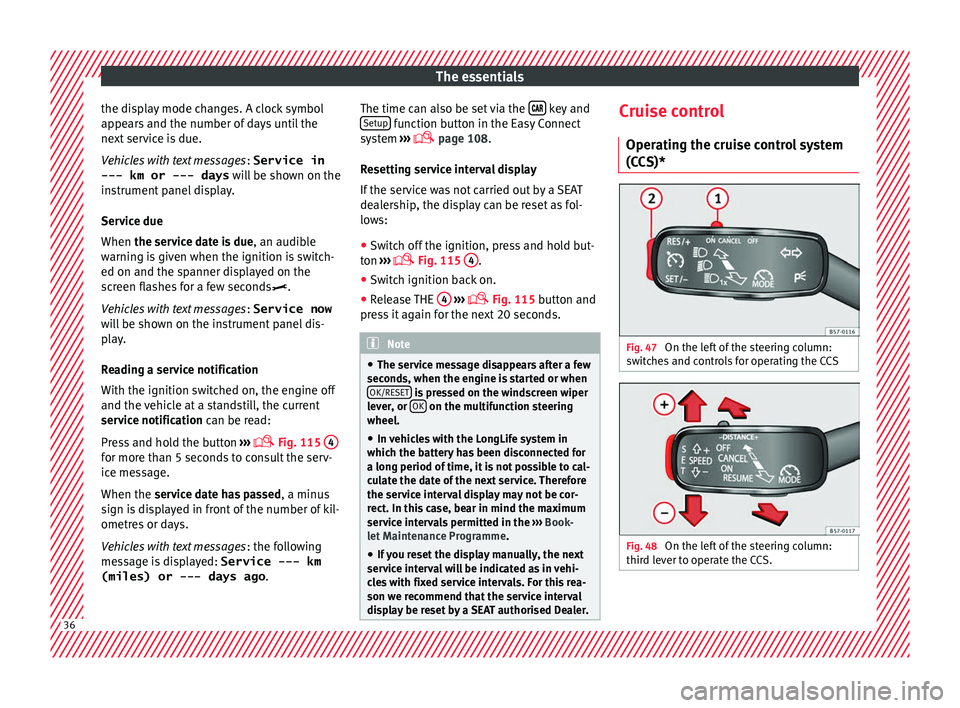
The essentials
the display mode changes. A clock symbol
ap pe
ars and the number of days until the
next service is due.
Vehicles with text messages : Service in
--- km or --- days will be shown on the
instrument panel display.
Service due
When the service date is due , an audible
warning is given when the ignition is switch-
ed on and the spanner displayed on the
screen flashes for a few seconds .
Vehicles with text messages : Service now
will be shown on the instrument panel dis-
play.
Reading a service notification
With the ignition switched on, the engine off
and the vehicle at a standstill, the current
service notification can be read:
Press and hold the button ›››
Fig. 115
4 for more than 5 seconds to consult the serv-
ic
e me
ssage.
When the service date has passed , a minus
sign is displayed in front of the number of kil-
ometres or days.
Vehicles with text messages : the following
message is displayed: Service --- km
(miles) or --- days ago .The time can also be set via the
key and
Set up function button in the Easy Connect
sy s
tem ›››
page 108.
Resetting service interval display
If the service was not carried out by a SEAT
dealership, the display can be reset as fol-
lows: ● Switch off the ignition, press and hold but-
ton ›
›› Fig. 115
4 .
● Switch ignition back on.
● Release THE 4
› ›
›
Fig. 115 button and
press it again for the next 20 seconds. Note
● The ser v
ice message disappears after a few
seconds, when the engine is started or when OK/RESET is pressed on the windscreen wiper
l ev
er, or OK on the multifunction steering
wheel .
● In
vehicles with the LongLife system in
which the b
attery has been disconnected for
a long period of time, it is not possible to cal-
culate the date of the next service. Therefore
the service interval display may not be cor- rect. In this case, bear in mind the maximum
service intervals permitted in the ››› Book-
let Maintenance Programme.
● If you reset the display manually, the next
serv
ice interval will be indicated as in vehi-
cles with fixed service intervals. For this rea-
son we recommend that the service interval
display be reset by a SEAT authorised Dealer. Cruise control
Oper atin
g the cruise control system
(CCS)* Fig. 47
On the left of the steering column:
sw it
ches and controls for operating the CCS Fig. 48
On the left of the steering column:
thir d l
ever to operate the CCS. 36
Page 66 of 328

Safety
●
Adju s
t the driver's seat so that there is at
least 25 cm distance between the centre of
the chest and the centre of the steering
wheel ››› Fig. 81. If you are sitting closer than
25 cm, the airbag system cannot protect you
properly.
● If your physical constitution prevents you
from m
aintaining the minimum distance of 25
cm, contact a specialised workshop. The
workshop will help you decide if special spe-
cific modifications are necessary.
● When driving, always hold the steering
wheel w
ith both hands on the outside of the
ring at the 9 o'clock and 3 o'clock positions.
This reduces the risk of injury when the driver
airbag is triggered.
● Never hold the steering wheel at the 12
o'cloc
k position, or in any other manner (e.g.
in the centre of the steering wheel). In such
cases, if the airbag is triggered, you may sus-
tain injuries to the arms, hands and head.
● To reduce the risk of injury to the driver
during s
udden braking manoeuvres or an ac-
cident, never drive with the backrest tilted far
back! The airbag system and seat belts can
only provide optimal protection when the
backrest is in an upright position and the
driver is wearing his or her seat belt correct-
ly.
● Adjust the head restraint properly to ach-
ieve optim
al protection. Adjusting the steering wheel position
Read the additional information carefully
› ›
› page 14. WARNING
● Nev er a
djust the position of the steering
wheel when the vehicle is moving, as this
could cause an accident.
● Move the lever up firmly so the steering
wheel po
sition does not accidentally change
during driving. risk of accident!
● Make sure you are capable of reaching and
firmly
holding the upper part of the steering
wheel: risk of accident!
● If you adjust the steering wheel so that it
points
towards your face, the driver airbag
will not protect you properly in the event of
an accident. Make sure that the steering
wheel points towards your chest. Correct sitting position for front pas-
sen
g
er For your own safety and to reduce the risk of
injur
y
in the event of an accident, we recom-
mend the following adjustments for the front
passenger:
– Move the front passenger seat back as far
as
possible ››› .–
Mo v
e the seat backrest to an upright posi-
tion so that your back rests completely
against it.
– Adjust the head restraint so that its upper
edge i
s at the same level as the top of your
head, or as close as possible to the same
level as the top of your head ››› page 66.
– Always keep both feet in the footwell in
front
of the front passenger seat.
– Fasten your seat belt securely ››
› page 68.
It is possible to deactivate the front passen-
ger airbag in exceptional circumstances
››› page 77.
Adjusting the front passenger seat
››› page 143. WARNING
● An inc orr
ect sitting position of the front
passenger can lead to severe injuries.
● Adjust the front passenger seat so that
there i
s at least 25 cm between your chest
and the dash panel. If you are sitting closer
than 25 cm, the airbag system cannot protect
you properly.
● If your physical constitution prevents you
from m
aintaining the minimum distance of 25
cm, contact a specialised workshop. The
workshop will help you decide if special spe-
cific modifications are necessary. 64
Page 91 of 328
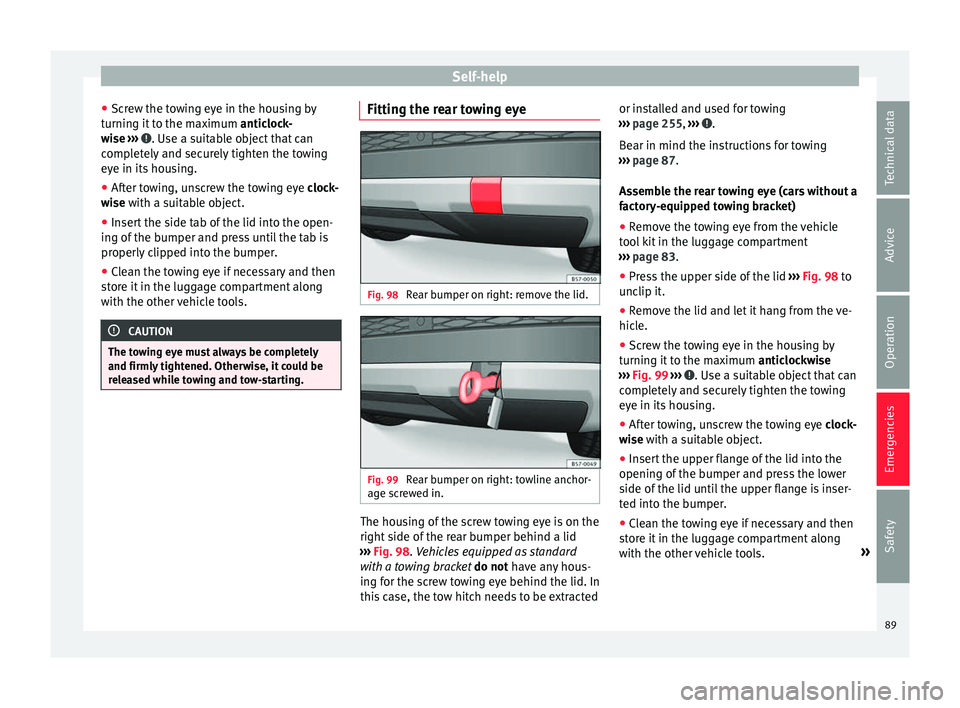
Self-help
● Sc r
ew the towing eye in the housing by
turning it to the maximum anticlock-
wise ››› . Use a suitable object that can
c omp
letely and securely tighten the towing
eye in its housing.
● After towing, unscrew the towing eye cloc
k-
wise with a suitable object.
● Insert the side tab of the lid into the open-
ing of
the bumper and press until the tab is
properly clipped into the bumper.
● Clean the towing eye if necessary and then
st
ore it in the luggage compartment along
with the other vehicle tools. CAUTION
The towing eye must always be completely
and firm ly
tightened. Otherwise, it could be
released while towing and tow-starting. Fitting the rear towing eye
Fig. 98
Rear bumper on right: remove the lid. Fig. 99
Rear bumper on right: towline anchor-
ag e s
crewed in. The housing of the screw towing eye is on the
right
s
ide of the rear bumper behind a lid
››› Fig. 98. Vehicles equipped as standard
with a towing bracket do not have any hous-
ing for the screw towing eye behind the lid. In
this case, the tow hitch needs to be extracted or installed and used for towing
››
› page 255, ››› .
B e
ar in mind the instructions for towing
››› page 87.
Assemble the rear towing eye (cars without a
factory-equipped towing bracket)
● Remove the towing eye from the vehicle
too
l kit in the luggage compartment
››› page 83.
● Press the upper side of the lid ››
› Fig. 98 to
unclip it.
● Remove the lid and let it hang from the ve-
hicl
e.
● Screw the towing eye in the housing by
turnin
g it to the maximum anticlockwise
››› Fig. 99 ››› . Use a suitable object that can
c omp
letely and securely tighten the towing
eye in its housing.
● After towing, unscrew the towing eye cloc
k-
wise with a suitable object.
● Insert the upper flange of the lid into the
opening of
the bumper and press the lower
side of the lid until the upper flange is inser-
ted into the bumper.
● Clean the towing eye if necessary and then
st
ore it in the luggage compartment along
with the other vehicle tools. »
89
Technical data
Advice
Operation
Emergencies
Safety
Page 96 of 328
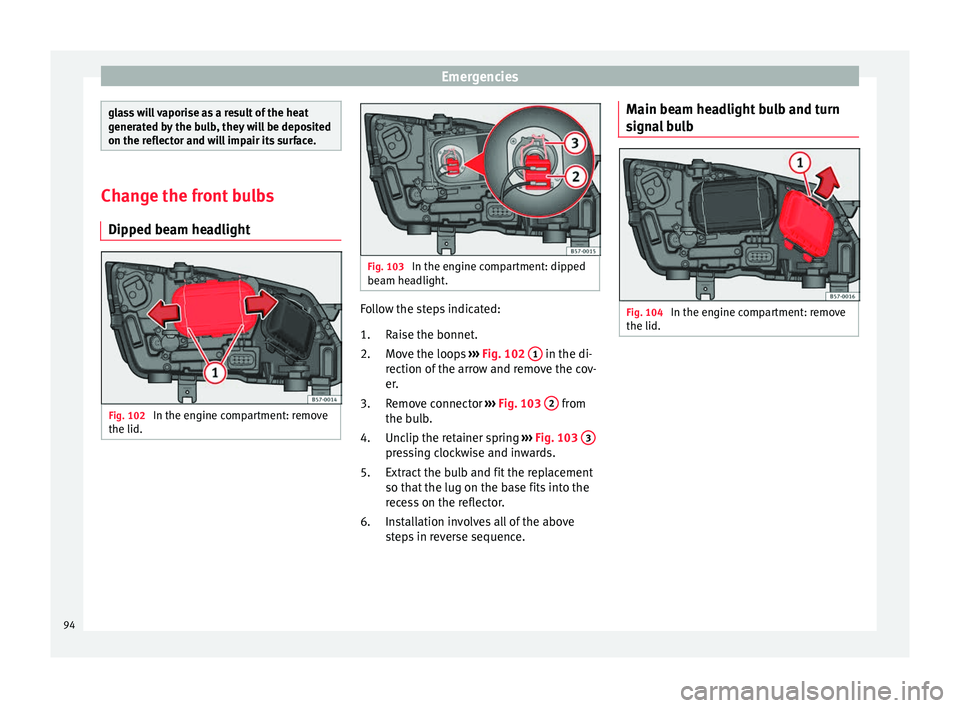
Emergencies
glass will vaporise as a result of the heat
g
ener
ated by the bulb, they will be deposited
on the reflector and will impair its surface. Change the front bulbs
Dip ped be
am headlightFig. 102
In the engine compartment: remove
the lid. Fig. 103
In the engine compartment: dipped
beam he
adlight. Follow the steps indicated:
Rai
se the bonnet.
Move the loops ›››
Fig. 102 1 in the di-
r ection of
the arrow and remove the cov-
er.
Remove connector ›››
Fig. 103 2 from
the b u
lb.
Unclip the retainer spring ›››
Fig. 103 3 pressing clockwise and inwards.
Extr
act
the bulb and fit the replacement
so that the lug on the base fits into the
recess on the reflector.
Installation involves all of the above
steps in reverse sequence.
1.
2.
3.
4.
5.
6. Main beam headlight bulb and turn
sign
al bulb Fig. 104
In the engine compartment: remove
the lid. 94
Page 97 of 328
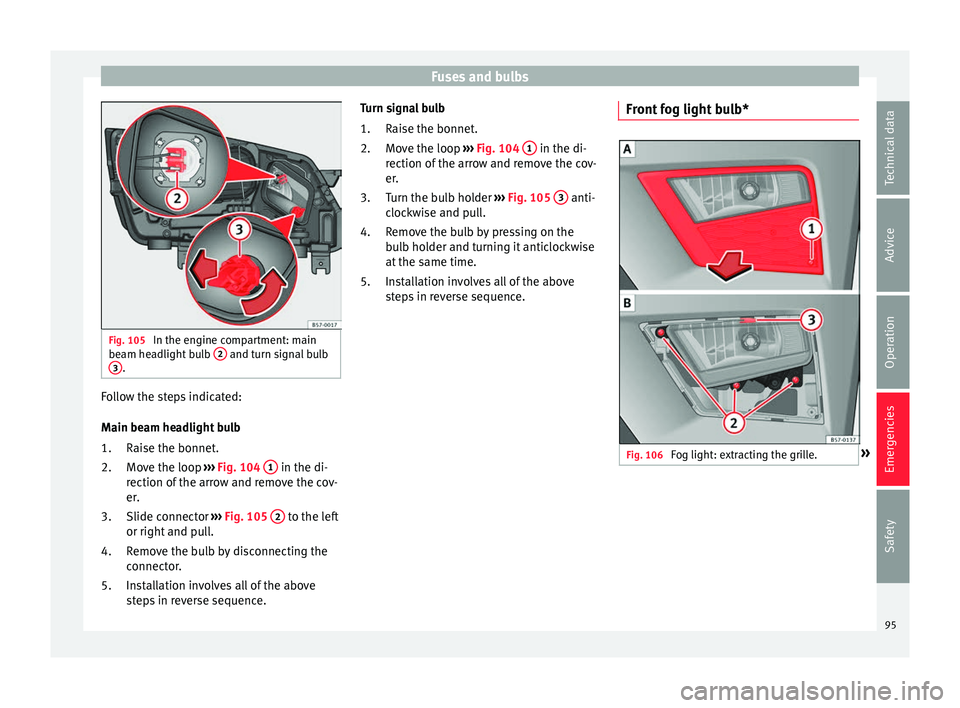
Fuses and bulbs
Fig. 105
In the engine compartment: main
be am he
adlight bulb 2 and turn signal bulb
3 .
Follow the steps indicated:
M
ain be
am headlight bulb
Raise the bonnet.
Move the loop ››› Fig. 104 1 in the di-
r ection of
the arrow and remove the cov-
er.
Slide connector ››› Fig. 105 2 to the left
or right and p
ull.
Remove the bulb by disconnecting the
connector.
Installation involves all of the above
steps in reverse sequence.
1.
2.
3.
4.
5. Turn signal bulb
Rai
se the bonnet.
Move the loop ››› Fig. 104 1 in the di-
r ection of
the arrow and remove the cov-
er.
Turn the bulb holder ››› Fig. 105 3 anti-
c loc
kwise and pull.
Remove the bulb by pressing on the
bulb holder and turning it anticlockwise
at the same time.
Installation involves all of the above
steps in reverse sequence.
1.
2.
3.
4.
5. Front fog light bulb* Fig. 106
Fog light: extracting the grille. » 95Technical data
Advice
Operation
Emergencies
Safety
Page 98 of 328
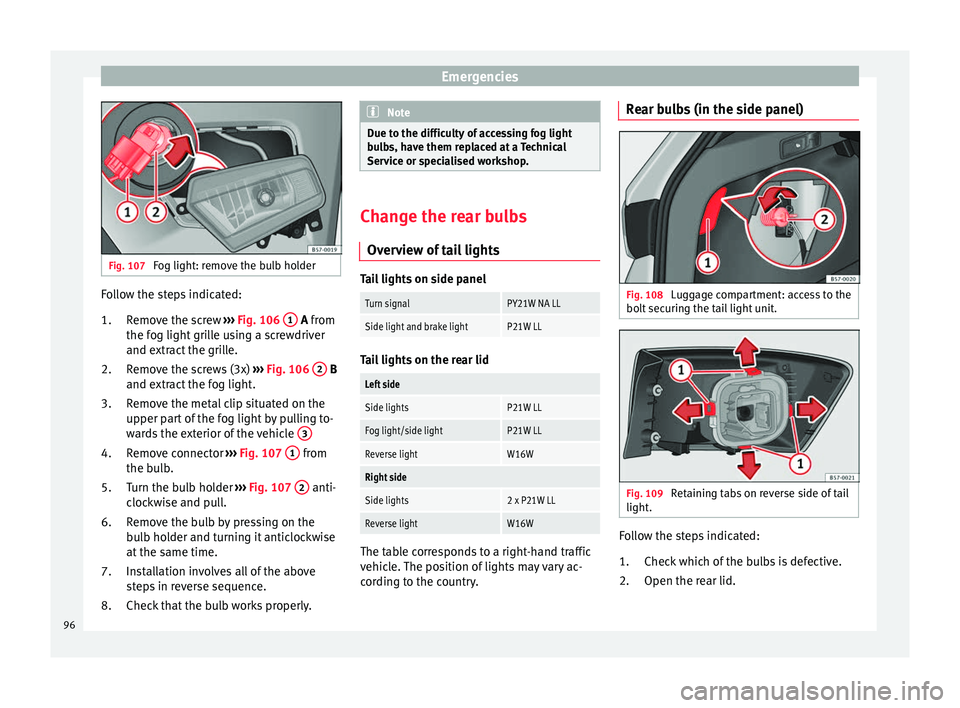
Emergencies
Fig. 107
Fog light: remove the bulb holder Follow the steps indicated:
Remo
ve the screw ››› Fig. 106 1 A fr
om
the f
og light grille using a screwdriver
and extract the grille.
Remove the screws (3x) ››› Fig. 106 2 B
and e xtr
act the fog light.
Remove the metal clip situated on the
upper part of the fog light by pulling to-
wards the exterior of the vehicle 3Remove connector
››
›
Fig. 107 1 from
the b u
lb.
Turn the bulb holder ›››
Fig. 107 2 anti-
c loc
kwise and pull.
Remove the bulb by pressing on the
bulb holder and turning it anticlockwise
at the same time.
Installation involves all of the above
steps in reverse sequence.
Check that the bulb works properly.
1.
2.
3.
4.
5.
6.
7.
8. Note
Due to the difficulty of accessing fog light
b u
lbs, have them replaced at a Technical
Service or specialised workshop. Change the rear bulbs
Ov er
view of tail lights Tail lights on side panel
Turn signalPY21W NA LL
Side light and brake lightP21W LL
Tail lights on the rear lid
Left side
Side lightsP21W LL
Fog light/side lightP21W LL
Reverse lightW16W
Right side
Side lights2 x P21W LL
Reverse lightW16W
The table corresponds to a right-hand traffic
v
ehic
le. The position of lights may vary ac-
cording to the country. Rear bulbs (in the side panel)
Fig. 108
Luggage compartment: access to the
bo lt
securing the tail light unit. Fig. 109
Retaining tabs on reverse side of tail
light . Follow the steps indicated:
Chec k
which of the bulbs is defective.
Open the rear lid.
1.
2.
96
Page 123 of 328
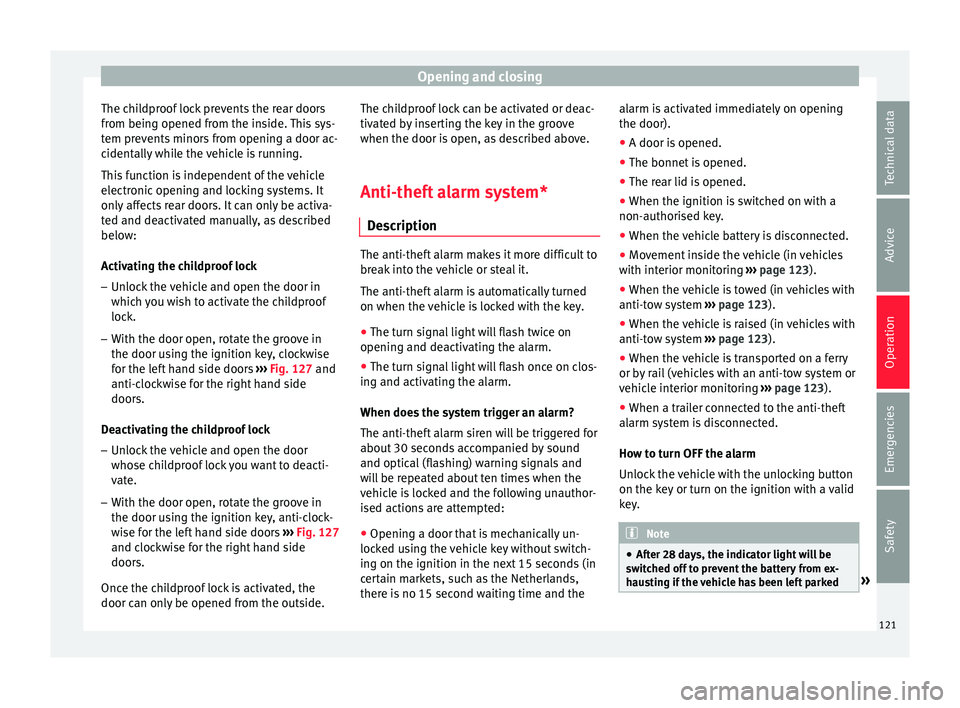
Opening and closing
The childproof lock prevents the rear doors
fr om bein
g opened from the inside. This sys-
tem prevents minors from opening a door ac-
cidentally while the vehicle is running.
This function is independent of the vehicle
electronic opening and locking systems. It
only affects rear doors. It can only be activa-
ted and deactivated manually, as described
below:
Activating the childproof lock
– Unlock the vehicle and open the door in
which
you wish to activate the childproof
lock.
– With the door open, rotate the groove in
the door us
ing the ignition key, clockwise
for the left hand side doors ››› Fig. 127 and
anti-clockwise for the right hand side
doors.
Deactivating the childproof lock
– Unlock the vehicle and open the door
whose c
hildproof lock you want to deacti-
vate.
– With the door open, rotate the groove in
the door us
ing the ignition key, anti-clock-
wise for the left hand side doors ››› Fig. 127
and clockwise for the right hand side
doors.
Once the childproof lock is activated, the
door can only be opened from the outside. The childproof lock can be activated or deac-
tivat
ed by inserting the key in the groove
when the door is open, as described above.
Anti-theft alarm system* De
scription The anti-theft alarm makes it more difficult to
br
e
ak into the vehicle or steal it.
The anti-theft alarm is automatically turned
on when the vehicle is locked with the key.
● The turn signal light will flash twice on
openin g and de
activating the alarm.
● The turn signal light will flash once on clos-
ing and activ
ating the alarm.
When does the system trigger an alarm?
The anti-theft alarm siren will be triggered for
about 30 seconds accompanied by sound
and optical (flashing) warning signals and
will be repeated about ten times when the
vehicle is locked and the following unauthor-
ised actions are attempted:
● Opening a door that is mechanically un-
lock
ed using the vehicle key without switch-
ing on the ignition in the next 15 seconds (in
certain markets, such as the Netherlands,
there is no 15 second waiting time and the alarm is activated immediately on opening
the door).
●
A door is opened.
● The bonnet is opened.
● The rear lid is opened.
● When the ignition is switched on with a
non-authori
sed key.
● When the vehicle battery is disconnected.
● Movement inside the vehicle (in vehicles
with int
erior monitoring ››› page 123).
● When the vehicle is towed (in vehicles with
anti-to
w system ››› page 123).
● When the vehicle is raised (in vehicles with
anti-to
w system ››› page 123).
● When the vehicle is transported on a ferry
or by
rail (vehicles with an anti-tow system or
vehicle interior monitoring ››› page 123).
● When a trailer connected to the anti-theft
alarm sy
stem is disconnected.
How to turn OFF the alarm
Unlock the vehicle with the unlocking button
on the key or turn on the ignition with a valid
key. Note
● Af t
er 28 days, the indicator light will be
switched off to prevent the battery from ex-
hausting if the vehicle has been left parked » 121
Technical data
Advice
Operation
Emergencies
Safety
Page 283 of 328
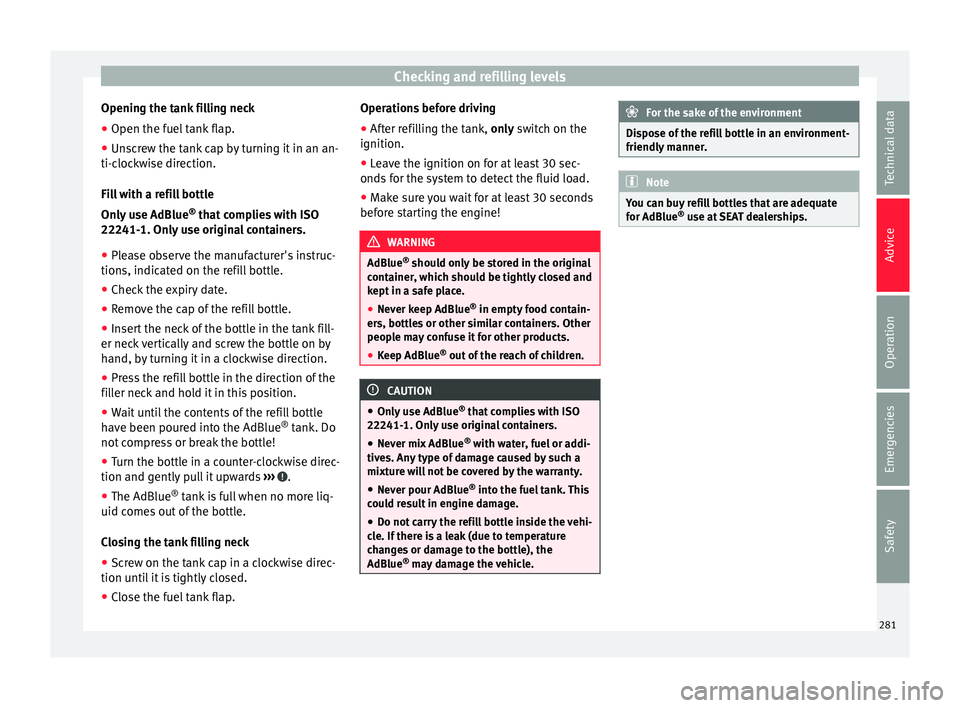
Checking and refilling levels
Opening the tank filling neck
● Open the fuel tank flap.
● Unscrew the tank cap by turning it in an an-
ti-c loc
kwise direction.
Fill with a refill bottle
Only use AdBlue ®
that complies with ISO
22241-1. Only use original containers.
● Please observe the manufacturer's instruc-
tions, indic
ated on the refill bottle.
● Check the expiry date.
● Remove the cap of the refill bottle.
● Insert the neck of the bottle in the tank fill-
er neck
vertically and screw the bottle on by
hand, by turning it in a clockwise direction.
● Press the refill bottle in the direction of the
fil
ler neck and hold it in this position.
● Wait until the contents of the refill bottle
hav
e been poured into the AdBlue ®
tank. Do
not compress or break the bottle!
● Turn the bottle in a counter-clockwise direc-
tion and gently
pull it upwards ››› .
● The AdBlue ®
tank
is full when no more liq-
uid comes out of the bottle.
Closing the tank filling neck
● Screw on the tank cap in a clockwise direc-
tion unti
l it is tightly closed.
● Close the fuel tank flap. Operations before driving
●
After refilling the tank, only
switch on the
ignition.
● Leave the ignition on for at least 30 sec-
onds
for the system to detect the fluid load.
● Make sure you wait for at least 30 seconds
befor
e starting the engine! WARNING
AdBlue ®
shou l
d only be stored in the original
container, which should be tightly closed and
kept in a safe place.
● Never keep AdBlue ®
in empty f
ood contain-
ers, bottles or other similar containers. Other
people may confuse it for other products.
● Keep AdBlue ®
out of
the reach of children. CAUTION
● On ly
use AdBlue ®
that complies with ISO
22241-1. Only use original containers.
● Never mix AdBlue ®
with w
ater, fuel or addi-
tives. Any type of damage caused by such a
mixture will not be covered by the warranty.
● Never pour AdBlue ®
into the f
uel tank. This
could result in engine damage.
● Do not carry the refill bottle inside the vehi-
cl
e. If there is a leak (due to temperature
changes or damage to the bottle), the
AdBlue ®
may damage the vehicle. For the sake of the environment
Dispose of the refill bottle in an environment-
friendly m
anner. Note
You can buy refill bottles that are adequate
f or AdBlue ®
u
se at SEAT dealerships. 281
Technical data
Advice
Operation
Emergencies
Safety
Page 291 of 328
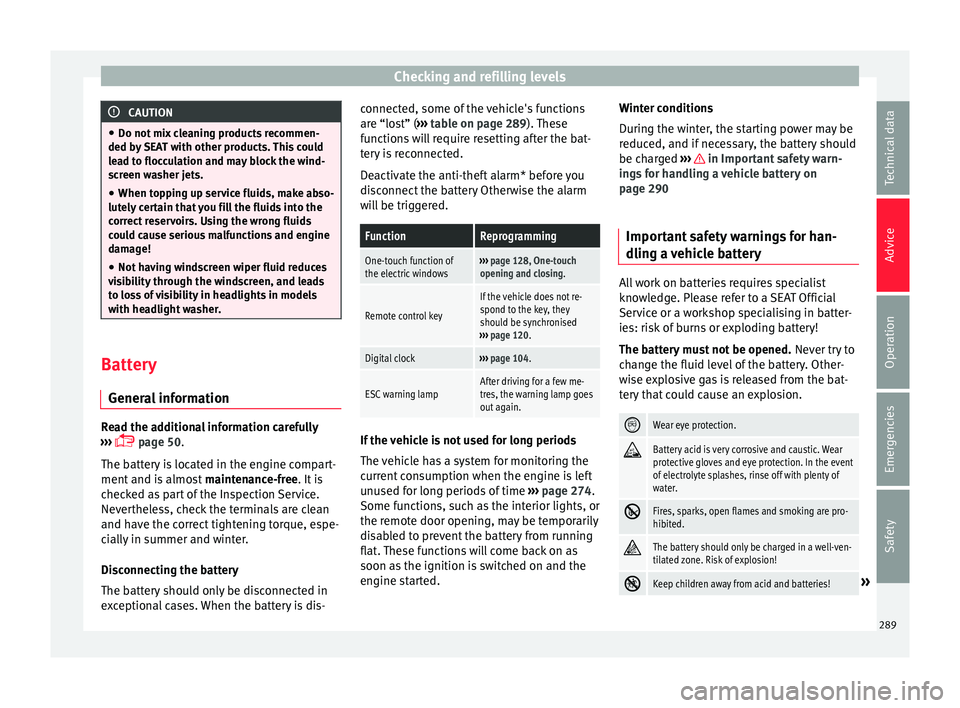
Checking and refilling levels
CAUTION
● Do not mi
x cleaning products recommen-
ded by SEAT with other products. This could
lead to flocculation and may block the wind-
screen washer jets.
● When topping up service fluids, make abso-
lutely
certain that you fill the fluids into the
correct reservoirs. Using the wrong fluids
could cause serious malfunctions and engine
damage!
● Not having windscreen wiper fluid reduces
vi
sibility through the windscreen, and leads
to loss of visibility in headlights in models
with headlight washer. Battery
Gener a
l information Read the additional information carefully
› ›
› page 50.
The battery is located in the engine compart-
ment and is almost maintenance-free. It is
checked as part of the Inspection Service.
Nevertheless, check the terminals are clean
and have the correct tightening torque, espe-
cially in summer and winter.
Disconnecting the battery
The battery should only be disconnected in
exceptional cases. When the battery is dis- connected, some of the vehicle's functions
are “lo
st” (››› table on page 289). These
functions will require resetting after the bat-
tery is reconnected.
Deactivate the anti-theft alarm* before you
disconnect the battery Otherwise the alarm
will be triggered.
FunctionReprogramming
One-touch function of
the electric windows››› page 128, One-touch
opening and closing.
Remote control key
If the vehicle does not re-
spond to the key, they
should be synchronised
››› page 120.
Digital clock››› page 104.
ESC warning lampAfter driving for a few me-
tres, the warning lamp goes
out again. If the vehicle is not used for long periods
The
v
ehicle has a system for monitoring the
current consumption when the engine is left
unused for long periods of time ››› page 274.
Some functions, such as the interior lights, or
the remote door opening, may be temporarily
disabled to prevent the battery from running
flat. These functions will come back on as
soon as the ignition is switched on and the
engine started. Winter conditions
Durin
g the winter, the starting power may be
reduced, and if necessary, the battery should
be charged ››› in Important safety warn-
in g
s for handling a vehicle battery on
page 290
Important safety warnings for han-
dling a
vehicle battery All work on batteries requires specialist
kno
wl
edge. Please refer to a SEAT Official
Service or a workshop specialising in batter-
ies: risk of burns or exploding battery!
The battery must not be opened. Never try to
change the fluid level of the battery. Other-
wise explosive gas is released from the bat-
tery that could cause an explosion.
Wear eye protection.
Battery acid is very corrosive and caustic. Wear
protective gloves and eye protection. In the event
of electrolyte splashes, rinse off with plenty of
water.
Fires, sparks, open flames and smoking are pro-
hibited.
The battery should only be charged in a well-ven-
tilated zone. Risk of explosion!
Keep children away from acid and batteries!»
289
Technical data
Advice
Operation
Emergencies
Safety
Page 300 of 328
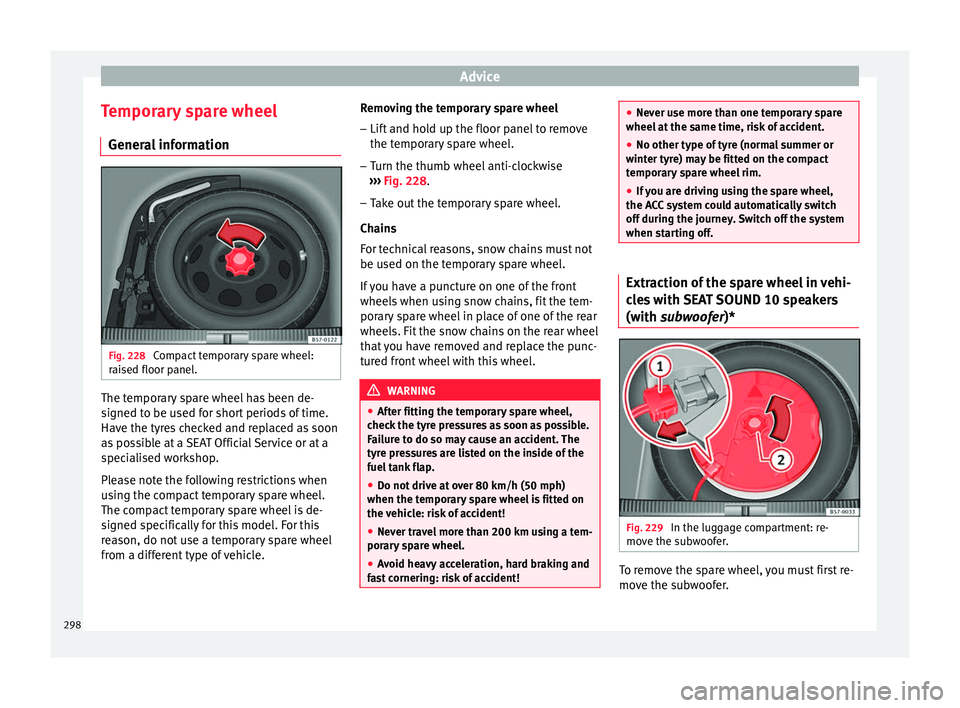
Advice
Temporary spare wheel Gener a
l information Fig. 228
Compact temporary spare wheel:
r ai
sed floor panel. The temporary spare wheel has been de-
s
igned t
o be used for short periods of time.
Have the tyres checked and replaced as soon
as possible at a SEAT Official Service or at a
specialised workshop.
Please note the following restrictions when
using the compact temporary spare wheel.
The compact temporary spare wheel is de-
signed specifically for this model. For this
reason, do not use a temporary spare wheel
from a different type of vehicle. Removing the temporary spare wheel
– Lift and hold up the floor panel to remove
the tempor
ary spare wheel.
– Turn the thumb wheel anti-clockwise
››
› Fig. 228.
– Take out the temporary spare wheel.
Chain
s
For technical reasons, snow chains must not
be used on the temporary spare wheel.
If you have a puncture on one of the front
wheels when using snow chains, fit the tem-
porary spare wheel in place of one of the rear
wheels. Fit the snow chains on the rear wheel
that you have removed and replace the punc-
tured front wheel with this wheel. WARNING
● Af t
er fitting the temporary spare wheel,
check the tyre pressures as soon as possible.
Failure to do so may cause an accident. The
tyre pressures are listed on the inside of the
fuel tank flap.
● Do not drive at over 80 km/h (50 mph)
when the tempor
ary spare wheel is fitted on
the vehicle: risk of accident!
● Never travel more than 200 km using a tem-
porar
y spare wheel.
● Avoid heavy acceleration, hard braking and
fa
st cornering: risk of accident! ●
Nev er u
se more than one temporary spare
wheel at the same time, risk of accident.
● No other type of tyre (normal summer or
wint
er tyre) may be fitted on the compact
temporary spare wheel rim.
● If you are driving using the spare wheel,
the AC
C system could automatically switch
off during the journey. Switch off the system
when starting off. Extraction of the spare wheel in vehi-
c
l
es with SEAT SOUND 10 speakers
(with subwoofer)* Fig. 229
In the luggage compartment: re-
mo v
e the subwoofer. To remove the spare wheel, you must first re-
mo
v
e the subwoofer.
298